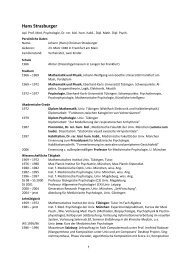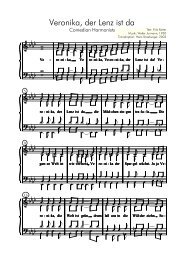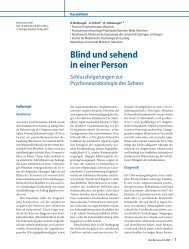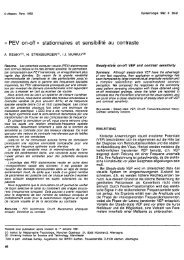Peripheral vision and pattern recognition: a review - strasburger - main
Peripheral vision and pattern recognition: a review - strasburger - main
Peripheral vision and pattern recognition: a review - strasburger - main
You also want an ePaper? Increase the reach of your titles
YUMPU automatically turns print PDFs into web optimized ePapers that Google loves.
<strong>Peripheral</strong>_Vision.doc<br />
empirical values <strong>and</strong> a logarithmic retino-cortical mapping function which matches the inverselinear<br />
law Further low-level tasks <strong>review</strong>ed are the measurements of visual reaction time,<br />
apparent brightness, temporal resolution, flicker detection, <strong>and</strong> spatial summation. These tasks<br />
have found application as diagnostic tools for perimetry, both in clinical <strong>and</strong> non-clinical<br />
settings.<br />
<strong>Peripheral</strong> letter <strong>recognition</strong> is a central topic in our <strong>review</strong>. In Chapter 4, we first consider its<br />
dependence on stimulus contrast. We then proceed to crowding, the phenomenon traditionally<br />
defined as loss of <strong>recognition</strong> performance for letter targets appearing in the context of other,<br />
distracting letters (Chapter 5). Crowding occurs when the distracters are closer than a critical<br />
distance specified by Bouma’s law (1970). We demonstrate its relationship with size-scaling<br />
according to cortical magnification <strong>and</strong> derive the equivalent of Bouma’s law in retinotopic<br />
cortical visual areas. Furthermore, we discuss how crowding is related to low-level contour<br />
interactions, such as lateral masking <strong>and</strong> surround suppression, <strong>and</strong> how it is modulated by<br />
attentional factors.<br />
Regarding the <strong>recognition</strong> of scenes, objects, <strong>and</strong> faces in peripheral <strong>vision</strong>, a key question is<br />
whether observer performance follows predictions based on cortical magnification <strong>and</strong> acuity<br />
measures (Chapter 6). Alternatively, it might be that configural information plays a role in the<br />
peripheral <strong>recognition</strong> of complex stimuli. Such information could result from mid-level<br />
processes of perceptual organization integrating local features into contours <strong>and</strong> contours into<br />
parts of objects or scenes.<br />
Of particular relevance for basic <strong>and</strong> clinical research is the possibility of improving peripheral<br />
form <strong>vision</strong> by way of learning (Chapter 7). Perceptual learning may enhance elementary<br />
functions such as orientation discrimination, contrast sensitivity, <strong>and</strong> types of acuity. This entails<br />
the question of whether crowding can be ameliorated or even removed by perceptual learning.<br />
We shall then proceed to consider possibilities of acquiring <strong>pattern</strong> categories through learning<br />
in indirect view. Of special interest is the extent of shift invariance of learned <strong>recognition</strong><br />
performance, <strong>and</strong> whether this imposes similar limitations on low-level <strong>and</strong> cognitive functions in<br />
peripheral <strong>vision</strong>.<br />
In Chapter 8 we <strong>review</strong> modeling peripheral form <strong>vision</strong> by employing concepts from computer<br />
<strong>vision</strong>, artificial neural networks, <strong>and</strong> <strong>pattern</strong> <strong>recognition</strong>. The most successful of these<br />
approaches are rooted in the above-mentioned work of Lettvin <strong>and</strong> Julesz <strong>and</strong> co-workers. That<br />
is, they modeled peripheral form <strong>vision</strong> by deteriorating structure within image parts using some<br />
sort of summary statistics. An alternative approach, termed the method of classification images,<br />
uses techniques of system identification. Finally, cognitive limitations of peripheral form <strong>vision</strong><br />
are explored using the analysis of category learning by means of psychometric methodologies<br />
based on statistical <strong>pattern</strong> <strong>recognition</strong>.<br />
4






